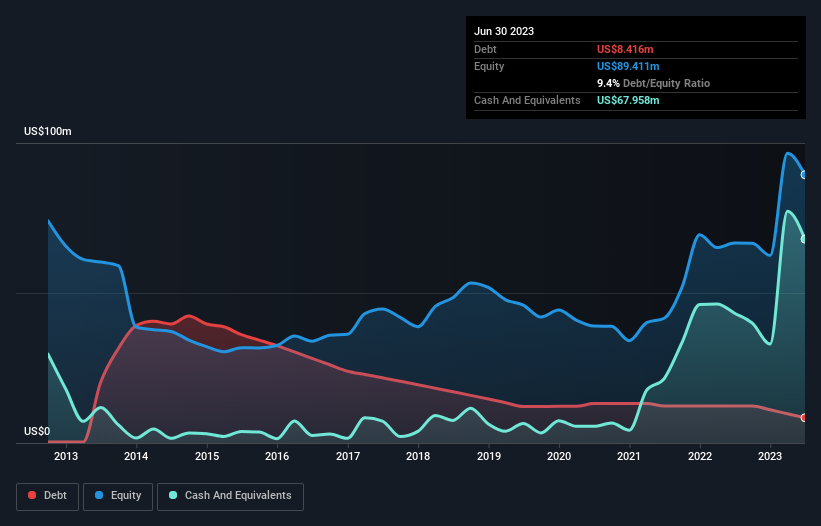The external fund manager backed by Berkshire Hathaway's Charlie Munger, Li Lu, makes no bones about it when he says 'The biggest investment risk is not the volatility of prices, but whether you will suffer a permanent loss of capital.' So it might be obvious that you need to consider debt, when you think about how risky any given stock is, because too much debt can sink a company. As with many other companies Ur-Energy Inc. (TSE:URE) makes use of debt. But is this debt a concern to shareholders?
When Is Debt Dangerous?
Debt is a tool to help businesses grow, but if a business is incapable of paying off its lenders, then it exists at their mercy. In the worst case scenario, a company can go bankrupt if it cannot pay its creditors. However, a more frequent (but still costly) occurrence is where a company must issue shares at bargain-basement prices, permanently diluting shareholders, just to shore up its balance sheet. By replacing dilution, though, debt can be an extremely good tool for businesses that need capital to invest in growth at high rates of return. The first thing to do when considering how much debt a business uses is to look at its cash and debt together.
View our latest analysis for Ur-Energy
What Is Ur-Energy's Debt?
The image below, which you can click on for greater detail, shows that Ur-Energy had debt of US$8.42m at the end of June 2023, a reduction from US$12.3m over a year. However, its balance sheet shows it holds US$68.0m in cash, so it actually has US$59.5m net cash.

How Healthy Is Ur-Energy's Balance Sheet?
We can see from the most recent balance sheet that Ur-Energy had liabilities of US$8.10m falling due within a year, and liabilities of US$42.1m due beyond that. Offsetting this, it had US$68.0m in cash and US$41.0k in receivables that were due within 12 months. So it can boast US$17.8m more liquid assets than total liabilities.
This surplus suggests that Ur-Energy has a conservative balance sheet, and could probably eliminate its debt without much difficulty. Simply put, the fact that Ur-Energy has more cash than debt is arguably a good indication that it can manage its debt safely. The balance sheet is clearly the area to focus on when you are analysing debt. But it is future earnings, more than anything, that will determine Ur-Energy's ability to maintain a healthy balance sheet going forward. So if you're focused on the future you can check out this free report showing analyst profit forecasts.
Over 12 months, Ur-Energy reported revenue of US$6.5m, which is a gain of 23,064%, although it did not report any earnings before interest and tax. When it comes to revenue growth, that's like nailing the game winning 3-pointer!
So How Risky Is Ur-Energy?
By their very nature companies that are losing money are more risky than those with a long history of profitability. And in the last year Ur-Energy had an earnings before interest and tax (EBIT) loss, truth be told. Indeed, in that time it burnt through US$18m of cash and made a loss of US$18m. Given it only has net cash of US$59.5m, the company may need to raise more capital if it doesn't reach break-even soon. The good news for shareholders is that Ur-Energy has dazzling revenue growth, so there's a very good chance it can boost its free cash flow in the years to come. High growth pre-profit companies may well be risky, but they can also offer great rewards. When analysing debt levels, the balance sheet is the obvious place to start. However, not all investment risk resides within the balance sheet - far from it. For example, we've discovered 2 warning signs for Ur-Energy (1 doesn't sit too well with us!) that you should be aware of before investing here.
When all is said and done, sometimes its easier to focus on companies that don't even need debt. Readers can access a list of growth stocks with zero net debt 100% free, right now.
New: AI Stock Screener & Alerts
Our new AI Stock Screener scans the market every day to uncover opportunities.
• Dividend Powerhouses (3%+ Yield)
• Undervalued Small Caps with Insider Buying
• High growth Tech and AI Companies
Or build your own from over 50 metrics.
Have feedback on this article? Concerned about the content? Get in touch with us directly. Alternatively, email editorial-team (at) simplywallst.com.
This article by Simply Wall St is general in nature. We provide commentary based on historical data and analyst forecasts only using an unbiased methodology and our articles are not intended to be financial advice. It does not constitute a recommendation to buy or sell any stock, and does not take account of your objectives, or your financial situation. We aim to bring you long-term focused analysis driven by fundamental data. Note that our analysis may not factor in the latest price-sensitive company announcements or qualitative material. Simply Wall St has no position in any stocks mentioned.
About TSX:URE
Ur-Energy
Engages in the acquisition, exploration, development, and operation of uranium mineral properties in the United States.
Adequate balance sheet and fair value.
Similar Companies
Market Insights
Community Narratives




